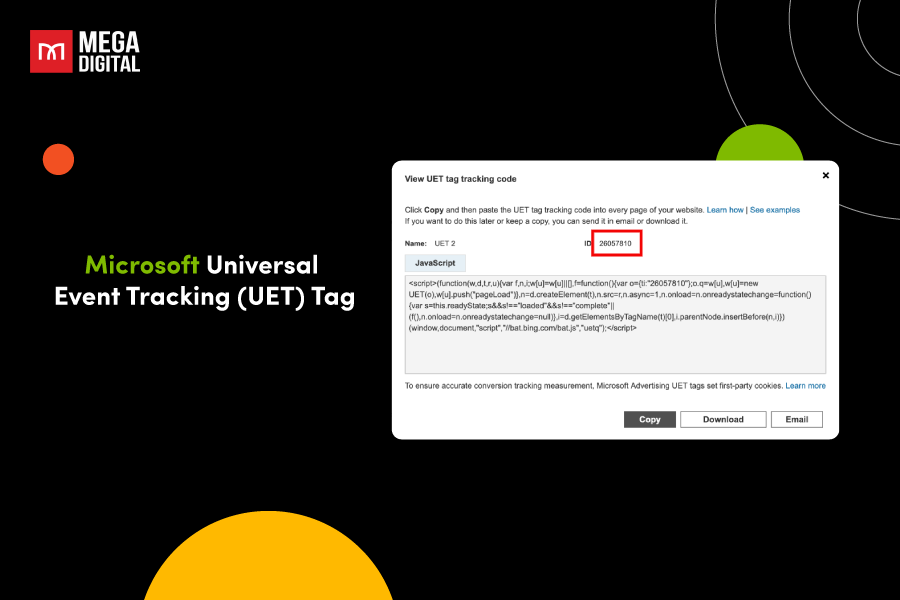If you’re an online retailer, you know how important it is to have your products listed on Google Shopping. But did you know that adding product ratings to your listings can help you stand out from the competition? In this article, we’ll take a deep dive into Google Product Ratings and how they can benefit your business.
- What are Google Product Ratings?
- Why are Google Product Ratings important?
- How do Product Ratings work?
- Product Ratings vs Seller Ratings?
- Google Shopping Product Ratings feed
- How to add Google Product Ratings to your listings
- How to select the method to acquire reviews?
- Best practices for displaying Google Product Ratings in Google Shopping
What are Google Product Ratings?
Google Product Ratings are a type of structured data that allows you to display product ratings and reviews in your Google Shopping listings. These star ratings reflect a collective assessment derived from various origins, encompassing input from merchants, review aggregators, review websites, and Google users.
The product ratings are featured in advertisements and complimentary product listings, showcasing a range from 1 to 5 stars and revealing the overall number of reviews received by the product.
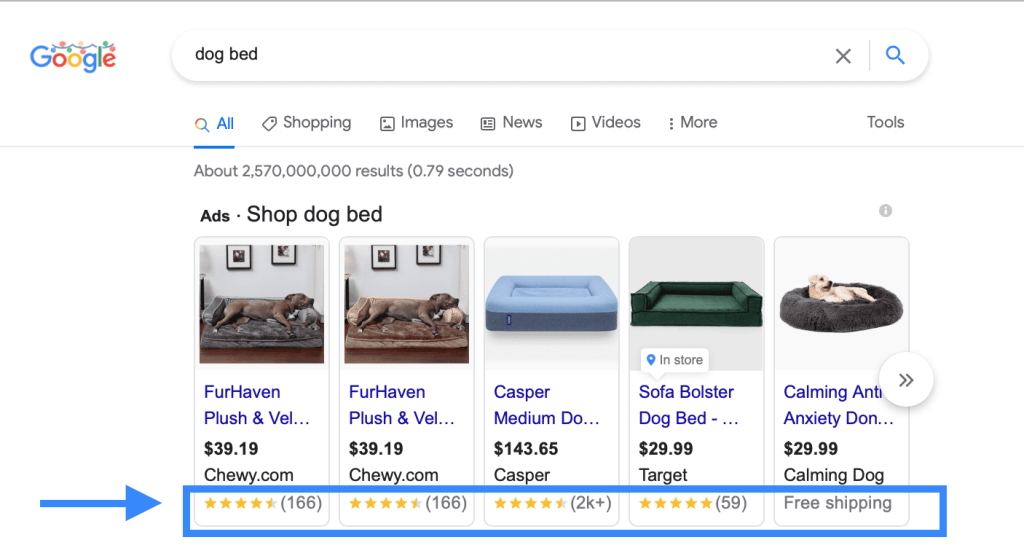
Upon clicking a Product Rating, users are directed to a comprehensive product page. This page provides access to complete ratings and reviews submitted by customers, along with details like pricing, offers, and Seller Ratings.
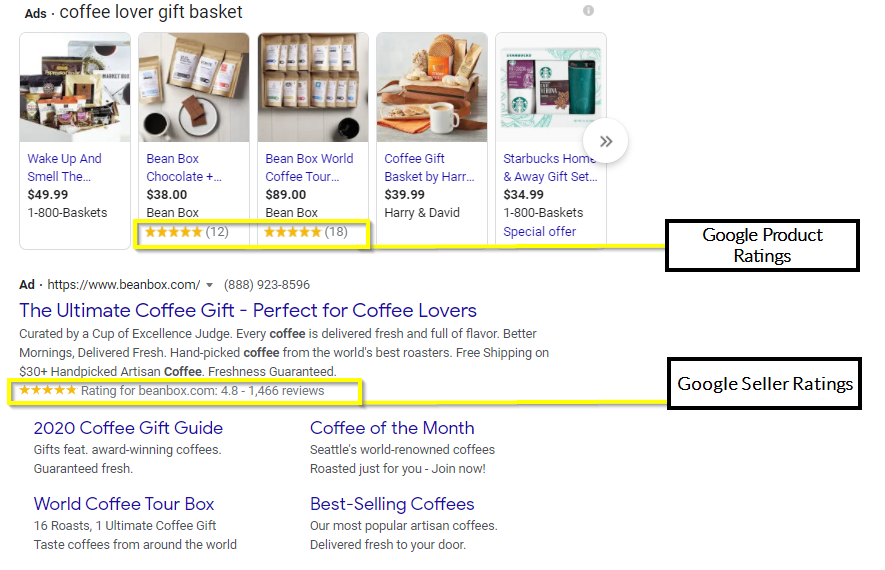
In practice, not every displayed product will feature a rating beneath it, as merchants are required to take specific steps to enable this occurrence.
As you can observe, only a couple of the numerous listed products have received ratings. Shoppers are more inclined to explore options that showcase this social proof, as opposed to those without any ratings.
Why are Google Product Ratings important?
Here are some reasons why Google Product Ratings are important:
Increased click-through rate (CTR)
Listings with product ratings see a 17% higher CTR than those without. This means that adding product ratings to your listings can help you attract more clicks and drive more traffic to your website.
Increased sales
Google Shopping ratings can help you build trust with potential customers and increase your sales. According to a study by PowerReviews, 82% of shoppers specifically seek out products with reviews. Additionally, 63% of shoppers are more likely to make a purchase from a site that has user reviews.
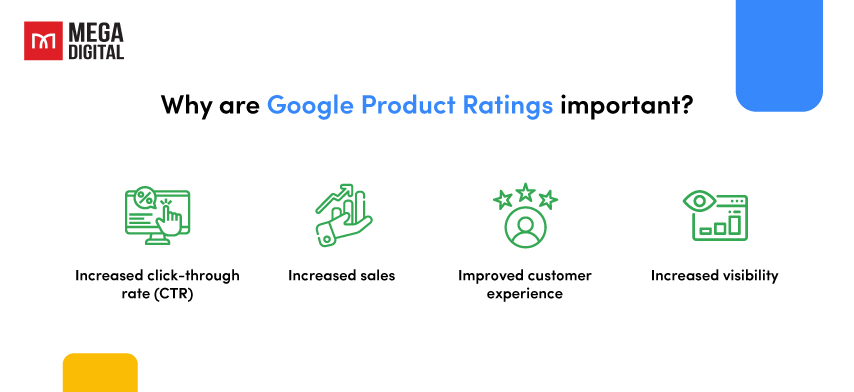
Improved customer experience
Product ratings help customers make informed purchase decisions and can drive more qualified customers to your product pages. By providing detailed information about your products, you can help customers find the products that best meet their needs.
Increased visibility
Listings with product ratings are more likely to appear at the top of Google Shopping search results. This means that adding product ratings to your listings can help you increase your visibility and attract more potential customers.
How do Product Ratings work?
Algorithms gather and incorporate product reviews from a variety of stores, marketplaces, and third-party review sites, facilitated by commonly used unique product identifiers. These identifiers encompass GTINs, brands, MPNs, or product URLs.
The outcome hinges on the specificity of the inquiry. If the query is more detailed, such as specifying the brand, color, or model, the Google Product Rating will be generated from reviews that you, and only you, have accumulated for that particular product. These reviews may be sourced from Google Customer Reviews, your own website, or a third-party review partner.
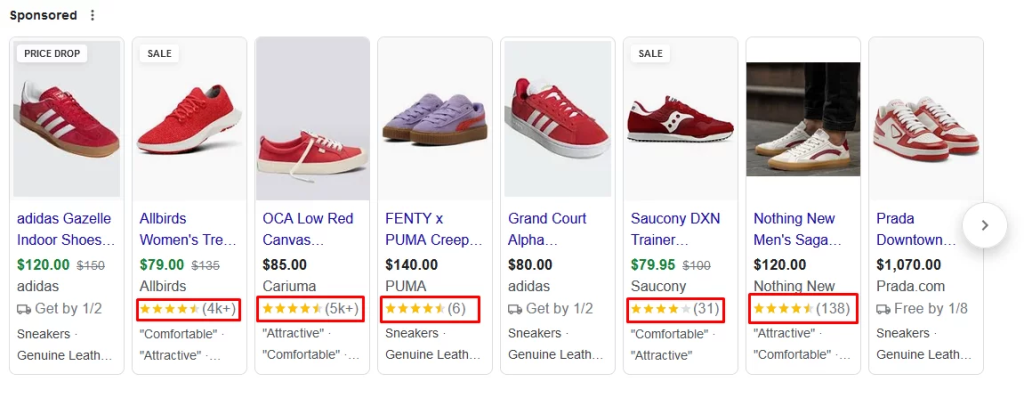
On the other hand, a generic search will yield a list of results with ratings appearing only where relevant. Clicking on a specific listing allows you to identify merchants selling that particular item.
Product Ratings vs Seller Ratings?
Seller Ratings and Product Ratings may appear similar, potentially causing confusion, but they serve distinct and equally crucial purposes.
- On Google Shopping, Product Ratings operate on a 5-star scale and pertain to individual products. Meanwhile, seller ratings are also showcased for eligible merchants, yet they differ from product ratings. Seller ratings provide an assessment of your overall business, whereas product ratings are specific to individual products.
- Google seller ratings assign a score to a brand based on customer reviews obtained from Google and various other review platforms like Trustpilot or PowerReviews. Seller ratings are visible in organic search results, Google Ads search, and Google Shopping listings.
- Product reviews contribute to SEO and on-site conversion, while seller reviews play a crucial role in establishing credibility, trust, and distinguishing your business from competitors.
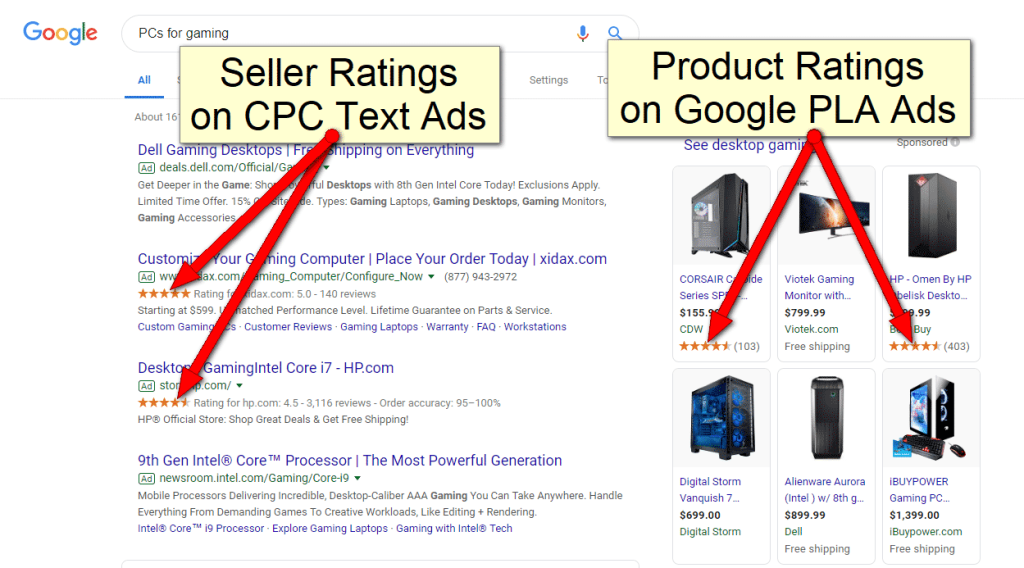
Google Shopping Product Ratings feed
In the preceding section, we discussed feeds for product ratings.
It’s crucial to highlight that if you opt to obtain your reviews through Google Customer Reviews, there is no requirement to submit a ratings feed. However, if you choose either of the other 2 methods, you will need to transmit your feed to Google Merchant Center.
Requirements for the feed include:
- Only XML files are compatible.
- Updates must be sent to Google at least once per month.
If you are accustomed to uploading spreadsheet files, it’s essential to recognize that XML files consist of code. Google offers resources for assistance.
This includes details such as review content, images, and links. A sample is provided below:
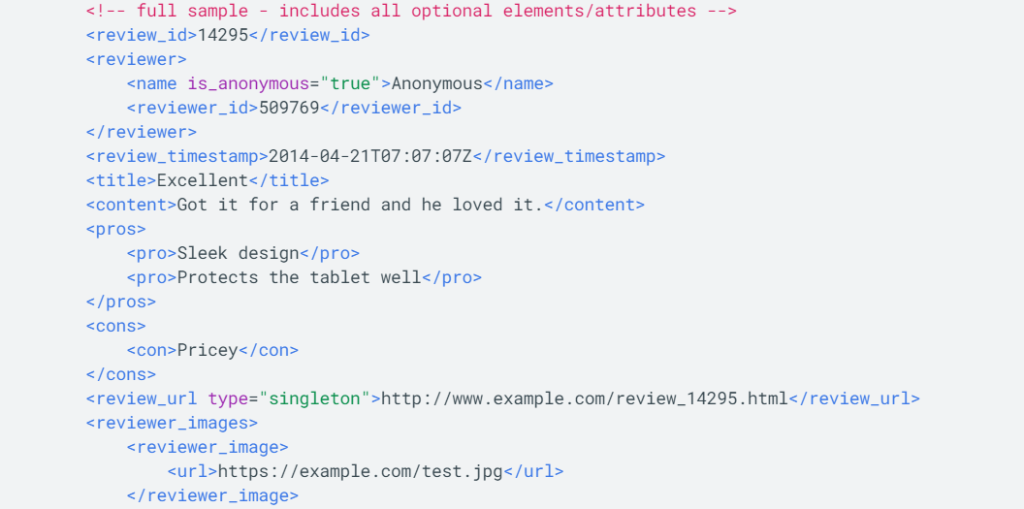
One of the key considerations when establishing product ratings on Google Shopping and configuring your feed is product matching. This process involves Google aligning the products in your feed with others by using industry-standard identifying information.
Incorporating product identifying details enhances not only your search results but also the accuracy of matching product ratings. This is because Google gains a more precise understanding of the specific products you offer, allowing them to appear in relevant searches.
Google employs 2 methods for product matching:
- GTIN: Global Trade Item Number, a unique identifier assigned to products for matching in various databases.
- Brand and MPN: Matching is also done based on the brand of the product combined with its Manufacturer Part Number (MPN).
For optimal results, it is recommended to include all three identifiers—GTIN, Brand, and MPN—in your feed.
How to add Google Product Ratings to your listings
Adding Google Product Ratings to your listings is a simple process. Let’s break down the steps to ensure your products receive ratings:
Step 1: Compliance with Standards and Policies
Ensure you meet all standards and policies, including having a Google Merchant Center account for Shopping advertising.
Product review eligibility on Google Shopping and free listings extends to 104 supported countries; verify the specific requirements, including the need for a company registration number (BRN) in some cases.
To display ratings on Google Shopping, a minimum of 50 reviews for each product is required.
Keep Google informed of your reviews monthly, promptly addressing any negative feedback, and ensure adherence to content restrictions, avoiding spam, hate speech, and duplicate reviews.
Maintain high-quality review feeds that offer valuable information to potential buyers, and retailers should manage their own customer reviews.
Once you’ve confirmed compliance with these requirements, proceed to enroll in the program.

Step 2: Request Membership in the Product Reviews Program
Contact Google to join the Product Reviews program by submitting a request form, accessible in 2 ways:
Option 1: Visit the Google Merchant Center and complete the form there.
Option 2: Log into your Merchant Center account, navigate to Manage Programs, scroll to Find Product Ratings, and click on “Get Started”.
Wait for Google to confirm your application before proceeding to upload your review feed.
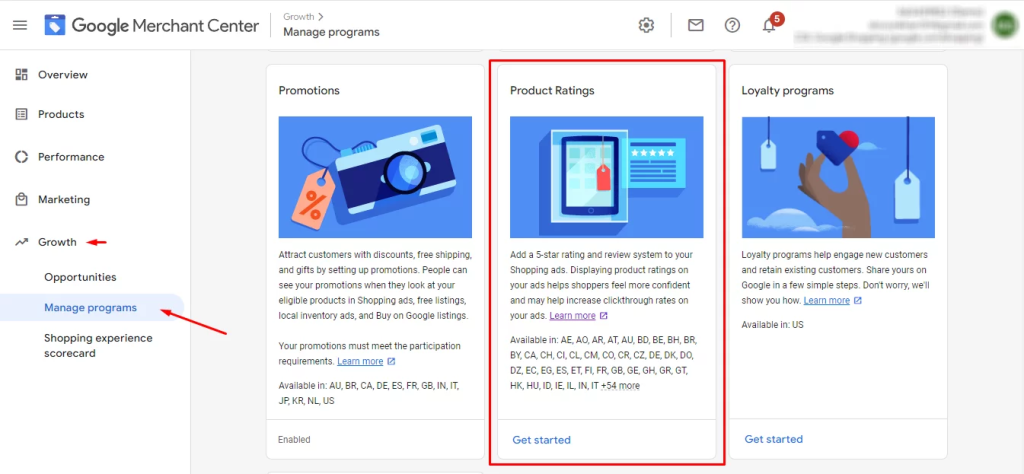
Step 3: Choose Review Collection Method
Decide whether to collect reviews through your online store or a third-party aggregator.
2 options for collecting product reviews are available: Using Google’s Review Collector or utilizing a third-party aggregator.
Think about which option best fits your specific needs.
How to select the method to acquire reviews?
Here are 3 approaches for gathering reviews for your Google listings.
#1 Add reviews manually
Manually adding reviews entails a more labor-intensive process, as it involves creating the product review feed and personally gathering reviews. The specifics of the feed will be explored in the upcoming section.
#2 Use Google Customer Reviews
Google Customer Reviews serves as Google’s solution to assist merchants in collecting reviews. It’s crucial to highlight that utilizing this method requires the provision of GTINs for your products.

Advantages include:
- You receive a Google certified review badge for your website.
- Unlike third-party apps, this method is cost-free.
- The setup process is simple.
However, there are certain disadvantages:
- The customer experience may not be optimal, as they fill out a Google survey rather than one you can customize.
- Customers must opt-in after making a purchase to receive a review request email.
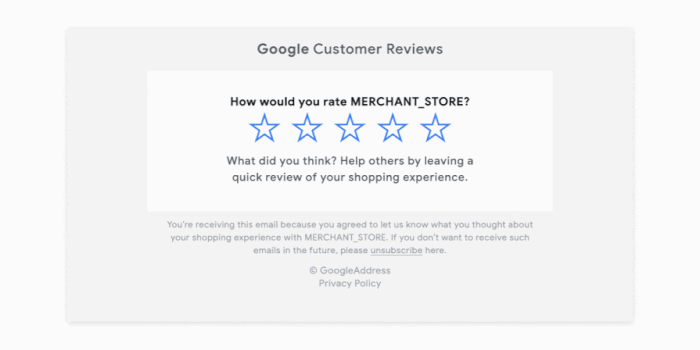
To establish Google Review Collection, follow these steps:
- Access your Merchant Center account.
- Navigate to the “Growth” section in the left-hand panel.
- Click on “Manage programs”.
- Locate the program labeled “Customer Reviews”.
- Enable the program and agree to the provided terms and conditions.
Subsequent steps may involve some coding to customize the module provided by Google for your website. If you have a developer, it might be beneficial to seek their assistance. Alternatively, if you prefer to try it yourself, you can refer to a guide on embedding Google reviews on websites for free.
Note: When a customer makes a purchase with multiple items, they will receive a single review survey. Google then selects which item to associate with this review based on internal criteria.
#3 Utilizing a third-party aggregator
- The benefits of employing a third-party review aggregator include:
- Automatic creation of a review feed.
- Simple setup of a scheduled feed in Merchant Center.
- Ability to send product review requests to customers with customized branding.
- Capability to gather reviews from various sources.
While there are limited drawbacks, one notable point is that these services typically involve costs and are not provided for free.
Best practices for displaying Google Product Ratings in Google Shopping
To maximize the benefits of Product Ratings on Google Shopping, it’s important to consider several key factors. Follow these recommended practices to optimize your use of Product Ratings:
Encourage User Reviews
Qualifying for Product Ratings depends on having a sufficient number of reviews. Moreover, accumulating a higher volume of reviews is crucial because consumers tend to place more trust in ratings based on substantial review numbers compared to those based on fewer reviews.
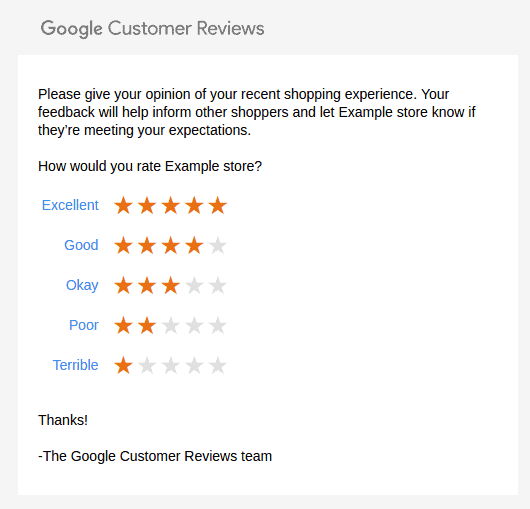
Diversify Review Ratings
Strive for a variety of ratings, not just 5-star reviews. Research indicates that 52% of people trust products with a mix of positive and negative reviews more than those with only positive feedback. Authenticity is key, and customers value ratings that reflect a genuine range of experiences.
Optimal Rating
Contrary to common belief, a perfect 5-star rating may not be ideal. Surprisingly, products with a rating of 4.7 tend to achieve more conversions than those with a flawless 5-star rating. Consumers often associate a 5-star rating with products that have a limited number of reviews, possibly from individuals affiliated with the company.
Include Seller Ratings
Extend your ratings beyond individual products by incorporating Seller Ratings. While the qualification criteria differ, having an overall store rating can assist shoppers in making informed purchasing decisions. Seller Ratings contribute to enhancing the quality of your listings and provide an additional layer of credibility.

Conclusion
In conclusion, Google Product Ratings are an essential tool for any online retailer looking to increase their visibility and sales. By following the best practices outlined in this article, you can ensure that your product ratings are accurate, up-to-date, and displayed in a way that will help you stand out from the competition.
I hope this article helps you understand the importance of Google Product Ratings and how to add them to your listings. If you have any questions or comments, contact us for more details.









